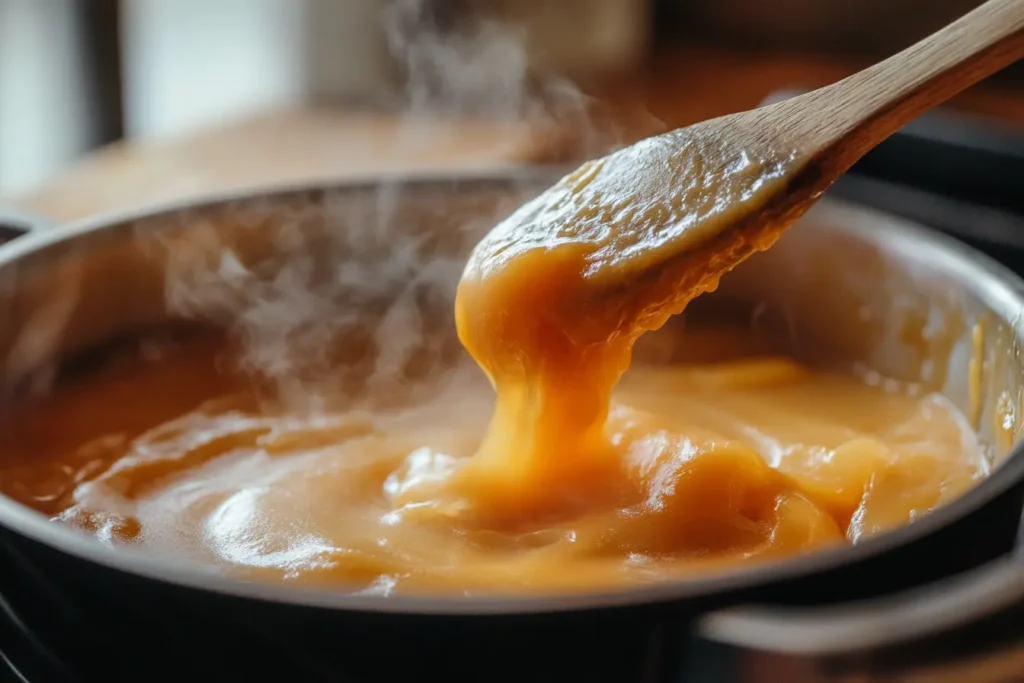The first time I experienced the rich flavors of both dulce de leche and tres leches cake was during my university years. As I explored different cultures through food, my roommate, a vibrant girl from Argentina, introduced me to the magic of dulce de leche. From the very first bite, I was completely hooked!
Around the same time, I tried tres leches at a local bakery. The creamy texture and sweet milkiness were unlike anything I’d ever experienced. Since then, I’ve always wondered, what’s the difference between them?
While both dulce de leche and tres leches are incredibly sweet and milky treats, they have distinct characteristics and uses. This article explores the differences and similarities between these two Latin American delights. I’ll share my knowledge of these treats, helping you understand their unique qualities and how to enjoy them.

What is Dulce de Leche?
Dulce de leche is a rich, creamy confection made from slowly heating sweetened milk. Think of it as a milk caramel. The slow cooking process transforms the sugar and milk, creating a magical alchemy of flavor and texture.
The Science Behind Dulce de Leche
The magic behind dulce de leche lies in two key processes: the Maillard reaction and caramelization. The Maillard reaction occurs when the sugars and proteins in the milk interact under heat, creating complex flavors and that beautiful golden brown color. Caramelization happens as the sugar itself breaks down and browns, adding another layer of deliciousness. The slow cooking allows these reactions to happen gradually, developing a deep, rich flavor.
Different Ways to Make Dulce de Leche
I learned to make dulce de leche the traditional way – in a pot on the stovetop. I simmer sweetened milk for hours, stirring often, until it thickens and turns a lovely caramel color. This method requires patience, but the result is incredibly rewarding.
A quicker method involves using a can of sweetened condensed milk. I submerge the unopened can in boiling water for a few hours, making sure it’s always fully covered. This method is convenient, but I always take safety precautions. A pressure cooker or microwave can also make dulce de leche, but these require careful monitoring to avoid burning.

What is Tres Leches Cake?
Tres leches, which translates to “three milks,” is a light and airy sponge cake soaked in a sweet, milky mixture. It’s a delightful dessert that’s both rich and refreshing. The cake itself acts like a sponge, soaking up the milk mixture and creating a wonderfully moist texture.
Components of Tres Leches Cake
The foundation of tres leches is a simple sponge cake. This type of cake is essential because of its ability to absorb the signature three milks. The three milks are evaporated milk, condensed milk, and heavy cream. Evaporated milk lends a subtle sweetness, condensed milk adds a thicker, richer texture, and heavy cream contributes a lovely creaminess. I sometimes see variations using coconut milk or whole milk for a slightly different flavor profile.
Baking and Serving Tres Leches
I start by baking the sponge cake until it’s golden and springy. Once the cake is cool, I poke holes all over the top using a fork or toothpick. This allows the milk mixture to soak in evenly. I then slowly pour the milk mixture over the cake, letting it absorb gradually.
Tres leches is best served chilled, allowing the flavors to meld and the cake to become fully saturated. I love to top it with whipped cream, fresh fruit, or even a drizzle of dulce de leche for an extra touch of sweetness. My twins, Lily and Mia, especially love it with strawberries.

Dulce de leche and Tres leches: A Detailed Comparison
While both dulce de leche and tres leches are sweet treats, they differ significantly in their flavor profiles, textures, and how I use them in the kitchen.
Flavor Profiles
Dulce de leche boasts a rich, caramelized flavor with notes of cooked milk and brown sugar. It’s intensely sweet and satisfying. Tres leches, on the other hand, offers a lighter, milky sweetness. The combined flavors of evaporated milk, condensed milk, and heavy cream create a balanced sweetness that’s not as intense as dulce de leche.
Texture and Consistency
Dulce de leche has a smooth, spreadable consistency, similar to thick caramel or frosting. I can drizzle it, spread it, or even use it as a filling. Tres leches cake has a moist, airy texture. The sponge cake soaks up the milk mixture, creating a delicate, melt-in-your-mouth experience.
Uses and Applications
I love using dulce de leche in various ways. It’s delicious as a filling for crepes, a topping for ice cream, or simply spread on toast. My girls love it with fruit! Tres leches is typically enjoyed as a standalone dessert. I serve it chilled, often garnished with whipped cream or fresh fruit.
Cultural Significance
Both dulce de leche and tres leches hold cultural significance in Latin America. Dulce de leche is a beloved treat across many countries, with each region having its own variations and traditions. Tres leches is also popular throughout Latin America, with variations appearing in different countries, showcasing the region’s diverse culinary heritage.

Delicious Recipes Featuring Dulce de Leche and Tres Leches
Now, I’m excited to share my favorite recipes for both dulce de leche and tres leches cake. These are easy-to-follow recipes perfect for any home cook.
Easy Dulce de Leche Recipe
This recipe uses the can method, which is my go-to for a quick and easy dulce de leche.
Ingredients:
- 1 can (14 ounces) sweetened condensed milk
Equipment:
- Large pot or Dutch oven
- Can opener
Instructions:
- Remove the label from the can of sweetened condensed milk.
- Place the unopened can in a large pot or Dutch oven.
- Fill the pot with enough water to cover the can completely by at least 2 inches.
- Bring the water to a rolling boil.
- Reduce the heat to a gentle simmer, ensuring the water remains at a consistent simmer.
- Simmer for 2-3 hours, checking the water level every 30 minutes and adding more boiling water as needed to keep the can fully submerged.
- After 2-3 hours, carefully remove the can from the pot using tongs.
- Allow the can to cool completely to room temperature before opening. This is crucial for safety and to prevent burns.
Tips & Safety Precautions:
- Never open a hot can of dulce de leche, as the contents can spurt out and cause burns.
- For a smoother, creamier dulce de leche, blend the cooled contents with an immersion blender or in a regular blender until smooth.
Classic Tres Leches Cake Recipe
This recipe is my family’s favorite. It’s simple to make and always a crowd-pleaser.
Ingredients:
- 1 box (15.25 ounces) white cake mix (plus ingredients listed on the box)
- 1 can (12 ounces) evaporated milk
- 1 can (14 ounces) sweetened condensed milk
- 1 cup heavy cream
- Optional toppings: Whipped cream, fresh fruit, dulce de leche
Equipment:
- 9×13 inch baking pan
- Mixer
- Whisk
Instructions:
- Preheat oven to 350°F (175°C). Grease and flour a 9×13 inch baking pan.
- Prepare the cake mix according to the package directions.
- Pour the batter into the prepared pan and bake for 30-35 minutes, or until a toothpick inserted into the center comes out clean.
- Let the cake cool in the pan for 10 minutes before poking holes all over the top using a fork or toothpick.
- In a bowl, whisk together the evaporated milk, condensed milk, and heavy cream.
- Slowly pour the milk mixture over the cooled cake, allowing it to soak in gradually.
- Cover and refrigerate for at least 4 hours, or preferably overnight, to allow the cake to fully absorb the milk mixture.
- Before serving, top with whipped cream, fresh fruit, or a drizzle of dulce de leche.
Tips for a Moist, Flavorful Cake:
- Don’t overbake the cake. A slightly underbaked cake will absorb the milk mixture better.
- Poke plenty of holes in the cake to ensure even soaking.
- Chill the cake thoroughly for optimal flavor and texture.
FAQ
Here are some common questions I often get about dulce de leche and tres leches.
Are caramel and dulce de leche the same?
While both dulce de leche and tres leches are sweet and brown, caramel and dulce de leche are different. Caramel is made by heating sugar, while dulce de leche is made by slowly heating sweetened milk. This difference in ingredients and process gives them distinct flavors. Caramel has a more burnt sugar taste, while dulce de leche has a cooked milk flavor.
What are the three milks in Tres Leches?
The “tres leches” in tres leches cake refers to evaporated milk, condensed milk, and heavy cream. Evaporated milk adds a light sweetness, condensed milk contributes a richer sweetness and thicker texture, and heavy cream brings the creaminess.
What do Mexicans call dulce de leche?
In Mexico, a similar confection is often called “cajeta,” especially when made with goat’s milk. However, the term “dulce de leche” is also commonly used and understood in Mexico.
Is dulce de leche just sweetened condensed milk?
Sweetened condensed milk is a key ingredient in making dulce de leche, but it’s not the same thing. Dulce de leche is made by cooking sweetened condensed milk until it caramelizes and thickens, changing its flavor and color.
Dulce de leche and tres leches, while both sweet and milky, offer distinct flavors and textures. Dulce de leche is a rich, caramelized confection, perfect as a filling, topping, or spread. Tres leches is a light, airy cake soaked in a sweet milk mixture, enjoyed as a refreshing dessert. I encourage you to try both and discover their unique qualities.
I remember when Lily and Mia first tried dulce de leche. They were hesitant at first, but one bite of dulce de leche on toast, and they were hooked! It’s become a favorite breakfast treat, and they even ask for it on pancakes and waffles. I hope you and your family enjoy these treats as much as we do.

